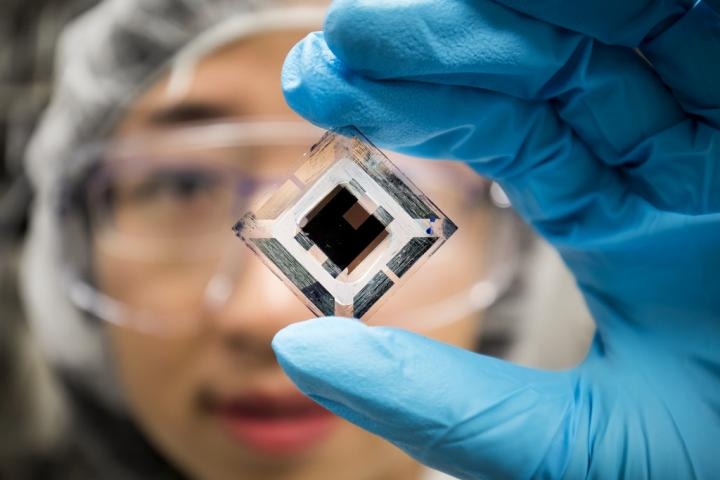Apr 25 2018
In a progress that makes a more flexible, economical type of solar cell commercially feasible, researchers at the University of Michigan have showcased organic solar cells that can attain 15% efficiency.
 2018 EECS Forrest Organic Solar Cell. (Image credit: Michigan Engineering)
2018 EECS Forrest Organic Solar Cell. (Image credit: Michigan Engineering)
This level of efficiency is in the variety of many solar panels, or photovoltaics, presently available.
"Organic photovoltaics can potentially cut way down on the total solar energy system cost, making solar a truly ubiquitous clean energy source," said Stephen Forrest, the Peter A. Franken Distinguished University Professor of Engineering and Paul G. Goebel Professor of Engineering, who guided the research.
At 15% efficiency and given a 20-year lifetime, the researchers reckon organic solar cells could yield electricity at a cost less than 7 cents per kilowatt-hour. According to the U.S. Energy Information Administration, the average cost of electricity in the U.S. was 10.5 cents per kilowatt-hour in 2017,
Organic solar cells include carbon into their structure to offer several benefits over conventional "inorganic" cells. Silicon-based inorganic solar panels are expensive to manufacture—made up of thick, stiff sheets that require fixed installation points.
But carbon-based organic solar cells could be economically manufactured in rolls that are quite to facilitate bending and curving around structures or within clothing and made in any color, even transparent, to merge with their environment.
Despite these benefits, organic solar cells are deficient in the efficiency needed to contend with conventional energy sources.
"For the last couple of years, efficiency for organic photovoltaics was stuck around 11 to 12 percent," said Xiaozhou Che, a doctoral candidate in the Applied Physics Program and first author of a new research published in Nature Energy.
To rescue them from this stagnation, the team incorporated several advancements in design and process.
First, they developed a system that integrates specialized layers to absorb both visible and infrared light. Basically, they stacked two organic solar cells—one with the capacity to absorb light from the visible spectrum beginning at 350 nm in wavelength, and the other with the capacity to absorb near-infrared light up to 950 nm in wavelength.
By themselves, the cells achieve 10- to 11-percent efficiency. When we stack them together, we increase light absorption and efficiency improves to 15 percent with an antireflection coating.
Xiaozhou Che
Innovation was required in the stacking of the cells. The team formed interconnecting layers that prevent damage to the first cell and still allow electrical and light charges to pass through.
"That's considered a difficult process because there's a chance the liquid used in processing the top cell will dissolve the layers already deposited underneath," Che said.
Finally, the team showed that their new design, materials, and process have a high fabrication yield of more than 95%. This means the researchers successfully created nearly all devices without short circuits and is vital for scaling up fabrication to an industrial scale.
In spite of setting record efficiency, the researchers believe they can scale their progress even more.
We can improve the light absorption to increase electric current, and minimize the energy loss to increase voltage. Based on calculations, an18-percent efficiency is expected in the near future for this type of multijunction device.
Xiaozhou Che
The research titled, "High fabrication yield organic tandem photovoltaics combining vacuum- and solution-processed subcells with 15% efficiency," has been published in Nature Energy on April 23, 2018.
Besides Forrest and Che, research co-authors include Yongxi Li, a postdoctoral fellow in the Department of Electrical Engineering and Computer Science, and Yue Qu, a doctoral student in electrical engineering.
The research received support from the SunShot Program of the Department of Energy and the Department of the Navy, Office of Naval Research.